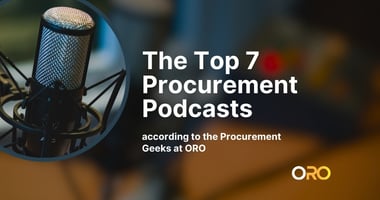In the fast-paced world of procurement and supply chain management, keeping up with the latest news...
Implementing ESG Sourcing Strategies with Procurement Orchestration
Navigating the Complexities of ESG Sourcing in Procurement
In today's business landscape, Environmental, Social, and Governance (ESG) considerations have emerged as critical factors influencing corporate strategy. Procurement departments, in particular, are increasingly tasked with integrating ESG principles into their sourcing practices. Beyond mere compliance, this entails codifying actionable ethical supply chain practices, mitigating risks, and aligning with stakeholder expectations. Embracing ESG metrics as part of a truly comprehensive risk and compliance program – and transparently reporting on the results – deserves to be taken seriously.
In this post, I'll explore the challenges that procurement teams face when working toward ESG goals, how disconnected systems exacerbate these challenges, and the ways that procurement orchestration solutions like ORO can help organizations to operationalize their ESG sourcing strategy.
Why Procurement Teams Struggle to Meet ESG Goals
Procurement departments encounter several challenges in effectively executing an ESG strategy:
Complex Monitoring: The manual nature of monitoring supplier compliance with ESG standards presents a significant challenge. Procurement teams struggle to keep pace with large and complex supplier landscapes, and with tracking a multitude of ESG metrics. Common issues include not knowing what or how to measure, inadequate technical and functional capabilities, resistance from suppliers, economic pressures leading to superficial compliance, and a lack of strong policy or regulatory incentives.
Data Overload: The abundance of data related to supplier performance and ESG metrics can overwhelm procurement teams. Analyzing this data comprehensively to identify trends and assess risks becomes daunting. This challenge is compounded by unclear metrics, limited analytical skills, resistance from suppliers, budget constraints, and insufficient regulatory pressure to improve data management and analysis.
Lack of Standardization: The absence of standardized processes and metrics for evaluating supplier ESG performance complicates decision-making. Inconsistent standards, gaps in knowledge and training, resistance from suppliers, economic pressures, and weak regulatory mandates all contribute to the difficulty in establishing uniform ESG evaluation criteria.
Limited Visibility: Inadequate visibility into supplier activities and performance gaps hampers procurement's ability to enforce ESG standards effectively. This lack of transparency increases the risk of non-compliance and potential reputational damage. Key factors include unclear measurement techniques, technical limitations, supplier resistance, economic pressures leading to concealed poor practices, and insufficient regulatory frameworks to encourage transparency.
How Siloed Systems Impede ESG Enablement
Siloed systems for Demand, Sourcing, Contract Management, Product/Supplier/Customer Master Data Management (MDM), ERP/MRP, and Procure to Pay (P2P) processes exacerbate these challenges:
End User Usability: Disjointed systems and processes impede user-friendly interaction, making it difficult for procurement and non-procurement professionals to access and utilize necessary data efficiently. Current approaches to ESG implementation are often marked by actions taken without clear purpose, adequate training, or established processes. Ad hoc and idiosyncratic processes are not sustainable and pose a significant risk to ESG program success. A lack of standardized procedures and user-friendly tools result in inefficient data handling and decision-making, undermining the effectiveness of ESG initiatives.
Collaboration: A lack of seamless integration across systems and processes hinders smooth communication and collaboration across departments and with suppliers, which is essential for ESG compliance and initiatives. Fragmented systems create barriers that prevent the free flow of information, leading to delays, misunderstandings, and missed opportunities for alignment on ESG goals.
Compliance Management: Fragmented systems make it challenging to establish, manage, and enforce compliance with corporate ESG policies. This fragmentation leads to inconsistent practices, increased risks of non-compliance, and potential breaches in ESG standards. Without a unified system, maintaining a coherent and enforceable ESG strategy becomes difficult, risking both regulatory penalties and reputational damage.
How Procurement Orchestration can Overcome ESG Challenges
To address these challenges, smart procurement workflow solutions like ORO offer valuable support:
User experience: By leveraging advanced AI, the complexity of the sourcing process is hidden from the requestor, making it straightforward and efficient. Seamless integration across various procurement systems enhances interactivity, facilitating smooth communication and collaboration across departments and with suppliers. This improved interactivity is essential for the successful implementation of ESG compliance and initiatives.
Automated Monitoring: By automating supplier activity monitoring, procurement orchestration platforms streamline the tracking of ESG-related key performance indicators (KPIs). This automation ensures timely detection of non-compliance and facilitates proactive risk management.
Data Analytics: Procurement orchestration solutions can aggregate and analyze large volumes of supplier performance and ESG metrics data. This analysis yields insights into trends, risks, and areas of non-compliance, guiding informed decision-making.
Standardized Supplier Scorecards: By aggregating data from multiple sources, a procurement orchestration solution can generate standardized supplier scorecards, providing a comprehensive view of performance, including adherence to ESG sourcing standards. Scorecards facilitate objective evaluation and aid in supplier management decisions.
Centralized Contract Management: Platforms like ORO enable centralized supplier contract management. They can identify ESG sourcing requirements within contracts where they are clearly defined, and discover contracts where they are not. This ensures compliance and facilitates auditability.
Integrated Risk Management: Procurement Workflow Orchestration integrates risk management capabilities to identify and mitigate potential risks associated with ESG non-compliance. This proactive approach helps safeguard the organization's reputation and financial health.
Enhanced Supplier Collaboration: Collaboration features foster communication and transparency between buyers and suppliers. This collaboration promotes ongoing dialogue about ESG initiatives and progress updates, fostering a culture of accountability and continuous improvement.
Assessing the Value of Procurement Orchestration
To financially justify an ESG sourcing strategy, organizations needs to demonstrate how integrating ESG criteria into procurement decisions can create business value. The value creation can be measured in terms of:
Revenue Growth: By enhancing its reputation, customer loyalty, innovation, and market access, an organization can increase its sales and profits, as well as gain competitive advantage and differentiation. ESG compliance facilitated by procurement orchestration can attract customers who prioritize sustainability, driving revenue growth.
Risk Management: By mitigating the potential negative impacts of ESG issues on its supply chain, such as disruptions, disputes, fines, sanctions, or boycotts, the organization can protect its brand, assets, and stakeholders, as well as comply with the relevant laws and regulations. Centralized risk management within Procurement Workflow Orchestration allows for proactive identification and mitigation of these risks.
Stakeholder Engagement: By communicating and collaborating with its internal and external stakeholders, such as employees, customers, investors, regulators, NGOs, and communities, an organization can improve its transparency, accountability, and trust, as well as align its interests and values. Enhanced supplier collaboration features in ORO foster better stakeholder engagement.
Cost Savings: By reducing waste, energy consumption, emissions, and risks, the organization can lower its operational and compliance costs, as well as negotiate better prices and terms with its suppliers. ORO can automate and streamline these processes, leading to significant cost reductions.
Of course, organizations should use appropriate methods and tools, such as cost-benefit analysis, return on investment (ROI), life cycle assessment, hurdle rates, and balanced scorecard, to estimate and communicate the financial value of their ESG sourcing strategy. Moreover, they should monitor and evaluate the performance and progress of the strategy, and report and disclose the results and impacts to its stakeholders.
Consistently executing ESG strategies in procurement is crucial for organizations committed to sustainability and corporate responsibility. By ensuring compliance with ESG standards, companies can reduce risks, enhance their reputation, and contribute to a more sustainable future.
ORO is uniquely positioned to support these efforts. Our GenAI-powered intake management approach provides users with effortless experiences and full visibility into supplier onboarding and assessment processes. An embedded best-in-class iPaaS and procurement semantics allow ORO to automate scorecard creation by extracting information from multiple sources. And because ORO is a no-code platform, it is easy to make workflow and scorecard changes in response to changes in the regulatory landscape and/or to business strategy.
With capabilities that automate monitoring, enable data-driven decision-making, foster collaboration, and mitigate risks, ORO empowers procurement departments to enforce ESG standards effectively.
Request a demo to learn more about how ORO can help you achieve your ESG goals.




.png?height=200&name=2%20(3).png)


